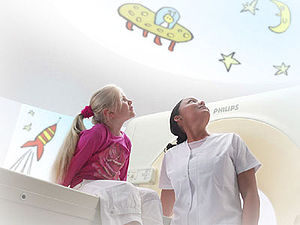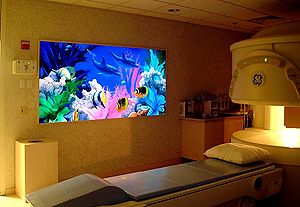
Paediatric radiology
Encyclopedia

Radiology
Radiology is a medical specialty that employs the use of imaging to both diagnose and treat disease visualized within the human body. Radiologists use an array of imaging technologies to diagnose or treat diseases...
involving the imaging of fetuses, infants, children, adolescents, and young adults. Many paediatric radiologists practice at children's hospital
Children's hospital
A children's hospital is a hospital which offers its services exclusively to children . The number of children's hospitals proliferated in the 20th century, as pediatric medical and surgical specialties separated from internal medicine and adult surgical specialties...
s.
Environment
To successfully diagnose a paediatric condition, high quality images are needed to give a diagnosis. To achieve this requires creating an environment where a child is comfortable. This is one of the most essential elements to paediatric radiology. For imaging departments which specialise in paediatric radiology, this is very easy as rooms can be tailored to suit a child's needs. For example bright wall designs, visual stimulation and toys. These can be permanent fixtures as the department wouldn't need to cater to any other age range. For departments which only see children occasionally, creating a 'child friendly' environment is more difficult. It is usually achieved by creating one room a 'child friendly room' where murals / stencils can be painted on the wall. Modern children's hospitals are now designed with lots of glass to allow as much natural light in as possible, the Evelina Children's HospitalEvelina Children's Hospital
Evelina Children's Hospital is a specialist NHS hospital in London. It is administratively a part of Guy’s & St Thomas’ NHS Foundation Trust and provides teaching hospital facilities for King's College London...
being one of these.

Challenges
Paediatric radiology comes with many challenges. Unlike adults, children cannot always understand / comprehend a change of environment. Therefore staff are usually required to wear colourful uniforms, usually 'scrubs', as opposed to a normal hospital uniform. It is also important to recognise that when a child is unwell, they follow their instincts, which is usually to cry and stay close to their parents. This presents a huge challenge for the radiographer, who must try to gain the child's trust and gain their co-operation. Once co-operation has been achieved there is another big challenge of keeping the child still for their imaging test. This can be very difficult for children in a lot of pain. Coercion and support from parents is usually enough to achieve this, however, in some extreme cases (such as MRI and CTComputed tomography
X-ray computed tomography or Computer tomography , is a medical imaging method employing tomography created by computer processing...
), it may be necessary to sedate the child.
Another challenge faced is the radiation difference between an adult and child.
Medical Use of Radiation: Medicine has used ionizing radiation for decades to help diagnose or treat children (and adults). There is no doubt that this imaging has saved lives. Medical imaging use has grown exponentially in the past few years, particularly the use of Cat Scans (also called CT scans). There are approximately 65 million CT scans done in the United States annually with an estimated 8 million in children. However, there is a much higher radiation dose from CT scans than from the traditional radiographs and fluoroscopy tests that radiologists perform and interpret. CT scans provide much more information about the anatomy and diseases in the body. To do this, though, they may expose a person to 100 to 250 times the radiation dose compared to a chest x-ray.
Radiation Safety Issues: There are risks from ionizing radiation that are comprehensively studied in the survivors of the atomic bomb in Hiroshima in 1945. Longitudinal studies led by the National Academy of Sciences in the United States have shown increased cancer rates in this population that are dose dependent. From these data, modelling research suggests that even at the lower doses used in medical imaging, there may be an added risk of cancer. Last year, two medical physicists suggested that the increasing use of Cat Scans in the United States may increase cancer incidence in the future.
Paediatric Radiation Protection Issues: Children are more radiosensitive than adults. They also have a longer life expectancy over which they may develop cancer from exposures to ionizing radiation. The paediatric radiology and medical community has long had an awareness of this issue and has developed radiation protection policies and practices that reflect this. With the increased use of imaging and in particular, CT scanning, there is increasing attention to this issue by the entire medical and radiology communities.An educational resource for health care providers as well as patients and parents is the Image Gently web site started in 2008.http://www.imagegently.com There is collaboration by several radiology, medical physics, paediatrics, and governmental organizations to increase awareness of radiation safety issues in children and to provide education to all stakeholders caring for children on ways to decrease the ionizing radiation exposure in children http://www.imagegently.com. There is information for parents that include basic information brochures that can be printed or downloaded that describe what is an xray, what are the risks and benefits, and what can be done to decrease these risks http://www.pedrad.org/associations/5364/ig/index.cfm?page=388.
Equipment
Some equipment adapted for use in paediatric radiology includes:- Artificial Windows / light panels
- Positioning equipment such as sponges, weights.
Most equipment is the same used for adult imaging, but using lower dose and exposure setting adapted for children.
Paediatric radiology
In many countries, paediatric radiology does not officially require a specific training. Where there is, paediatric radiologists have usually completed a radiologyRadiology
Radiology is a medical specialty that employs the use of imaging to both diagnose and treat disease visualized within the human body. Radiologists use an array of imaging technologies to diagnose or treat diseases...
residency
Residency (medicine)
Residency is a stage of graduate medical training. A resident physician or resident is a person who has received a medical degree , Podiatric degree , Dental Degree and who practices...
, then complete two more years of subspecialty fellowship training before they are eligible to take the board examination for official subspecialty certification (e.g. UK, Switzerland). This then qualifies them in the specialised area of paediatric radiology.
Although some diseases seen in paediatrics are the same as that in adults, there are many conditions which are seen only in infants. The specialty has to take in account the dynamics of a growing body, from pre-term infants to large adolescents, where the organs follow growth patterns and phases. These require specialised imaging and treatment which is carried out in a Children's hospital, which has all the facilities necessary to treat children and their specific pathologies.
Common paediatric pathologies requiring imaging
- Wilms' tumour
- LeukaemiaLeukemiaLeukemia or leukaemia is a type of cancer of the blood or bone marrow characterized by an abnormal increase of immature white blood cells called "blasts". Leukemia is a broad term covering a spectrum of diseases...
- TeratomaTeratomaA teratoma is an encapsulated tumor with tissue or organ components resembling normal derivatives of all three germ layers. There are rare occasions when not all three germ layers are identifiable...
- Congenital abnormalities
- OsteosarcomaOsteosarcomaOsteosarcoma is an aggressive cancerous neoplasm arising from primitive transformed cells of mesenchymal origin that exhibit osteoblastic differentiation and produce malignant osteoid...
- MeningitisMeningitisMeningitis is inflammation of the protective membranes covering the brain and spinal cord, known collectively as the meninges. The inflammation may be caused by infection with viruses, bacteria, or other microorganisms, and less commonly by certain drugs...
- Infant respiratory distress syndromeInfant respiratory distress syndromeInfant respiratory distress syndrome , also called neonatal respiratory distress syndrome or respiratory distress syndrome of newborn, previously called hyaline membrane disease, is a syndrome in premature infants caused by developmental insufficiency of surfactant production and structural...
- Juvenile idiopathic arthritisJuvenile idiopathic arthritisJuvenile idiopathic arthritis is the most common form of persistent arthritis in children. JIA is a subset of arthritis seen in childhood, which may be transient and...
- Greenstick fractureGreenstick fractureA greenstick, buckle or torus fracture is a fracture in a young, soft bone in which the bone bends and partially breaks. A person's bones become harder and more brittle with age. Greenstick fractures usually occur most often during infancy and childhood when bones are soft...
s
External links
- Royal College of Paediatrics and Child Health
- the European Society for Paediatric Radiology
- Society for Pediatric Radiology
- Sociedad Latinoamericana de Radiología Pediátrica
- PedRad - International Pediatric Radiology platform for doctors and patients
- http://www.aospr.org/
- Image Gently
- Information kit for parents and children, consisting of animation and tools, pdfs and frequently asked questions, how the examination procedures work

